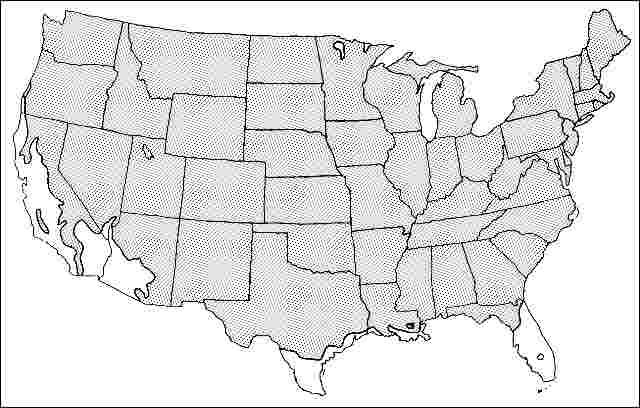Introduction
Bur oak is a huge tree reaching a height and spread of 70 to 90 feet and has an impressive crown, massive trunk, and stout branches. There is a specimen in Philadelphia which is about seven feet in diameter and over 90 feet wide. Bark is an unusual light brown to grey depending on the specimen, and is deeply furrowed on older trees. Young stems have corky ridges making them appear stout. Acorns are almost completely covered with a furry, bur-like cap and are large, creating a sizeable clean-up job in a maintained landscape. Young trees have an attractive, symmetrical, dense crown and they are well-suited for street tree planting. Architects like the tree due to its uniformity in crown shape.

Credit: UF/IFAS Extension
General Information
Scientific name: Quercus macrocarpa
Pronunciation: KWERK-us mack-roe-KAR-puh
Common name(s): Bur oak
Family: Fagaceae
USDA hardiness zones: 3A through 8B (Fig. 2)
Origin: native to North America
Invasive potential: little invasive potential
Uses: specimen; street without sidewalk; shade; parking lot island > 200 sq ft; tree lawn > 6 ft wide; urban tolerant; highway median
Availability: not native to North America

Description
Height: 70 to 90 feet
Spread: 60 to 80 feet
Crown uniformity: symmetrical
Crown shape: round, spreading
Crown density: dense
Growth rate: moderate
Texture: coarse
Foliage
Leaf arrangement: alternate (Fig. 3)
Leaf type: simple
Leaf margin: lobed, undulate
Leaf shape: oblong, obovate
Leaf venation: pinnate
Leaf type and persistence: deciduous
Leaf blade length: 4 to 8 inches, 8 to 12 inches
Leaf color: green
Fall color: copper, yellow
Fall characteristic: showy

Flower
Flower color: brown
Flower characteristics: not showy
Fruit
Fruit shape: oval
Fruit length: .5 to 1 inch, 1 to 3 inches
Fruit covering: dry or hard
Fruit color: brown
Fruit characteristics: attracts squirrels/mammals; showy; fruit/leaves a litter problem
Trunk and Branches
Trunk/bark/branches: branches droop; showy; typically one trunk; thorns
Pruning requirement: little required
Breakage: susceptible to breakage
Current year twig color: brown
Current year twig thickness: thick
Wood specific gravity: 0.64
Culture
Light requirement: full sun
Soil tolerances: clay; sand; loam; alkaline; acidic; well-drained; extended flooding
Drought tolerance: high
Aerosol salt tolerance: high
Other
Roots: not a problem
Winter interest: no
Outstanding tree: yes
Ozone sensitivity: tolerant
Verticillium wilt susceptibility: resistant
Pest resistance: resistant to pests/diseases
Use and Management
Trees are well-suited for street, park and parking lot planting but enough soil space should be available to accommodate growth. This large oak should not be planted in tree lawn strips less than 10 feet wide. However, if soil is not compacted, roots usually stay below the soil surface and do not lift sidewalks or curbs.
This oak will adapt to various soils where other oaks sometimes fail but is difficult to transplant from well-drained soil due to the tap root. As with most trees grown in urban areas, the tap root becomes much less prominent as the tree grows older, giving way to a more shallow, horizontal root system. It is well-adapted to alkaline soils, poor drainage, high clay content, and is very drought-tolerant.
Propagation of oaks by seed is the most common.
Pests
No pests are normally serious.
Galls cause homeowners much concern. There are many types and galls can be on the leaves or twigs. Most galls are harmless so chemical controls are not suggested.
Scales of several types can usually be controlled with sprays of horticultural oil.
Aphids cause distorted growth and deposits of honeydew on lower leaves. On large trees, naturally-occurring predatory insects will often bring the aphid population under control.
Boring insects are most likely to attack weakened or stressed trees. Newly planted young trees may also be attacked. Keep trees as healthy as possible with regular fertilization and water during dry weather.
Many caterpillars (including gypsy moth) feed on oak. Large trees tolerate some feeding injury without harm. Trees repeatedly attacked, or having some other problem, may need spraying. Tent caterpillars form nests in trees then eat the foliage. The nests can be pruned out when small. Where they occur, gypsy moth caterpillars are extremely destructive on oaks.
Twig pruner causes twigs to drop off in the summer. The larvae ride the twig to the ground. Rake up and destroy fallen twigs. Fall cankerworm has been a problem in some years.
Spider mite infested leaves first look dusty then yellowed.
Lace bugs suck juices from leaves causing them to look dusty or whitish gray.
Leaf miners cause brown areas in leaves. To identify leaf miner injury tear the leaf in two across the injury. If the injury is due to leaf miner, upper and lower leaf surfaces are separate and black insect excrement will be seen.
Diseases
No diseases are normally serious. Bur oak is more or less resistant to oak wilt.
Anthracnose may be a serious problem in wet weather. Infected leaves have dead areas following the midrib or larger veins. These light brown blotches may run together and, in severe cases, cause leaf drop. Trees of low vigor, repeatedly defoliated, may die. Trees defoliated several years in a row may need spraying, to allow the tree to recover.
Canker diseases attack the trunk and branches. Keep trees healthy by regular fertilization. Prune out diseased or dead branches.
Leaf blister symptoms are round raised areas on the upper leaf surfaces causing depressions of the same shape and size on lower leaf surfaces. Infected areas are yellowish-white to yellowish-brown. The disease is most serious in wet seasons in the spring but it does not need to be treated.
A large number of fungi cause leaf spots but are usually not serious. Rake up and dispose of infected leaves.
Powdery mildew coats leaves with white powdery growth.
Shoestring root rot attacks the roots and once inside moves upward, killing the cambium. The leaves on infected trees are small, pale or yellowed and fall early. There is no practical control. Healthy trees may be more resistant than trees of low vigor.